How To Overcome Your Internet Porn Addiction – Complete Guide


- Reward pathways and addiction
- Symptoms of Internet porn addiction
- How Internet porn addiction causes these diverse symptoms and conditions
- The reward circuits of the brain
- Reward circuits: seeking pleasure and avoiding pain
- Dopamine: an anticipation of pleasure
- From mice to men
- Dopamine: the fuel for wanting
- Seek more than we are satisfied
- Why Internet porn is similar to drug addiction
- A quest for novelty
- Meet the Coolidge effect
- Internet pornography and the Coolidge effect
- Super-normal stimulus at work
- Young men showing no interest in 'real' sex
- How Internet porn elevates dopamine levels
- Ever more shocking genres of porn to keep dopamine souring
- Are you an 'edger'?
- What are the consequences of all this dopamine?
- Skewing what's acceptable sexual behaviour
- Replacing the need for real sexual experiences
- Rewiring reward pathways and sensitisation
- What is sensitisation?
- DeltaFosB and genetic survival via memory and repetition
- Sensitised pathways remain even when you quit your addiction
- Nerve cells that fire together will wire together
- Neuroplasticity: how new reward pathways arise
- The dangers of watching porn for adolescent males
- Competing pathways for porn and normal sexual experiences
- Conditions that encourage unnatural pathways for Internet porn addiction
- Similarities between Internet porn and drug addiction
- Incentive salience: when wanting is divorce from liking
- The 4 Cs Of Addiction
- Internet porn withdrawal symptoms
- Brain changes associated with Internet porn addiction
- How desensitisation affects Internet porn addicts
- Desensitisation and the 'acquisition' of new fetishes
- How desensitisation occurs
- A decline in dopamine: a loss of 'grey matter'
- Weakening of Hypo-frontal lobes and loss of willpower
- Altered stress response due to porn addiction
- Rebooting: a viable cure?
- Becoming a participant rather than a voyeur
- Masturbation during a reboot
- Activities that speed up your reboot
- Fading unhealthy pathways and strengthening healthy pathways
- A word of warning
- Useful Resources
How To Overcome Your Internet Porn Addiction – The Complete Guide
In this post, we discuss the hot topic of Internet porn addiction. Millions of men across the globe are thought to be suffering with Internet porn addiction. A recent study says around 33% of males aged between 16-34 years old are addicted to Internet porn and this figure is growing every day as high-speed Internet is combing more wide spread.
Are You Addicted to Internet Porn? Click Here to Take Our Short Quiz to Find Out
We explain how Internet porn hijacks your brain’s reward circuits and how Internet porn weakens the logical part of your brain’s ability to exercise willpower over your addiction to Internet porn. By the time you have finished reading this post, you will hopefully be highly motivated to finally ridding your life of Internet pornography once and for all.
Reward pathways and addiction
Our brains are full of pathways. Every time we learn something new, a new pathway is created. The more you practice a new skill, the stronger the associated pathway becomes in your brain. At some point, the skill becomes unconscious precisely because the pathway associated with the skill becomes so engrained. Unfortunately, this process also happens with addiction. Porn addiction rewired the brain by creating a new neural pathway. One of the key things that help us remember this map is a chemical called dopamine. Dopamine serves to remind us of the things that are most pleasurable in our lives. Anything that triggers dopamine is something that will strengthen your neural pathway.
Unfortunately, this process also happens with addiction. Porn addiction rewires the brain by creating a new neural pathway. One of the key things that help us remember this pathway is a chemical called dopamine. Dopamine serves to remind us of the things that are most pleasurable in our lives. Anything that triggers dopamine is something that will strengthen your neural pathway.
For instance, let’s say going on holiday to Italy is your pathway. You now know that going to Italy is very exciting and it’s an activity that makes you happy. The more you go to Italy, the more pronounced and automatic this neural pathway becomes. This pathway becomes a fast and easy route to accessing dopamine.
Recovery from this hypothetical addiction to Italy means not going to Italy and not thinking about Italy. When you fantasise about going to Italy, you actually trigger the dopamine pathway in the same way as being exposed to going to Italy. Over time, this pathway will fade and become weaker and weaker. However, you must develop new pathways that allow you to access dopamine on a repetitive nature so these new pathways become stronger and stronger.
Now swap out ‘Italy’ for ‘Internet porn’ and you will begin to see where this is going…
Symptoms of Internet porn addiction
Below we outline physical symptoms and conditions linked to an addiction to Internet pornography:
- Chronic ejaculation dysfunction
- Angorgasmia/delayed ejaculation
- Brain fog and concentration problems
- Lethargy and lack of motivation
- Social anxiety and emotional numbness
- Declining interest in real partner
- Escalation to porn that doesn’t match your original sexual tastes or sexual orientation
All of the above conditions and symptoms are significantly removed when the sufferer ceases to watch Internet pornography
How Internet porn addiction causes these diverse symptoms and conditions
Internet porn addiction causes these symptoms and conditions because chronic Internet porn use alters the reward circuits in the brain from a chemical and structural standpoint. Modern neuro-science and recent studies on the brain support this hypothesis.
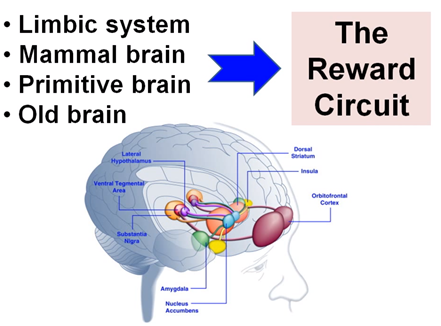
The reward circuits of the brain
The reward circuit of the brain is also known as the “limbic system” or “primitive brain”. This refers to our evolutionary ancient structures contained in the brain. These structures are involved in almost all emotional and physical function you may think of. These structures essentially keep us alive.
Changes in the reward circuits may affect any aspect of behaviour and may even physiological functions. The reward circuit shapes are moods and colours our emotions. Fear, joy and rage all arise from these evolutionary ancient structures. Most of our desires and drives arise in the reward circuit, such as hunger for food, power or sex. The reward circuit also allows us to become addicted to certain behaviours.
Alterations to the reward circuits are responsible for most mental disorders such as post-traumatic stress disorder, anxiety, bipolar disorder, schizophrenia, depression and social anxiety.
Reward circuit structures such as the hypothalamus and the Amygdala influence or control major functions such as male sexual behaviours, erections, the autonomic nervous system and endocrine system. The bottom line is that chemical or structural alterations to the reward circuit may result in wide and varying effects.
Reward circuits: seeking pleasure and avoiding pain
At its most basic level, the reward circuit allows us to seek pleasure and to avoid pain. Our very survival depends on the avoidance of pain and the repetition of pleasure. To this end, the reward circuit encourages us to engage in activities that either further our survival or the survival of our genes. These activities include sex, eating, bonding, achievement, play, novelty and taking risks.
We literally do not make a decision without consulting our reward circuit. The reward circuit emotionally justifies what we do like and what we don’t like. When you are addicted to something, your reward circuit is out of balance. This affects your mood, your perception and your decision-making powers.
Dopamine: an anticipation of pleasure
Dopamine is one of the major chemicals that powers the reward system. Think of the reward system as the engine behind most of our decision making and dopamine as the fuel that powers up that engine. Dopamine is known as the ‘craving’ neuro-chemical that sends out a message saying “you HAVE to have it NOW!”. This ‘it’ may be food, sex, heroin, cocaine or your next porn video on a ‘Tube’ website.
From mice to men
When an electrode is implanted into the reward circuit of a mouse, the mouse will keep pressing a button that stimulates its reward signal until the mouse is exhausted. The mouse will continue pressing the lever until it dies of starvation. Artificially stimulating the reward circuit tricks the rat’s brain into believing it’s about to achieve something that will protect its survival, even though it clearly isn’t. This situation is not unlike an addiction to Internet pornography.
Much of all Internet use mimics this lab mouse pushing this lever. Via the Internet, we have at our disposal an endless stream of novelty. With each like, share, page load or email, we receive a small ‘squirt’ of dopamine. Each squirt of dopamine is interpreted by the brain as an act that’s promoting our survival, even though this is not the case.
When scientists block dopamine, the mouse has little motivation to sleep, mate or eat. If food is placed in this rat’s mouth, he will eat it. But the rat will not exert enough energy to walk over to a tray of food in order to satisfy his hunger. When a willing female is presented to him, mouse rat fails to mate with her.
Dopamine: the fuel for wanting
Scientists believe dopamine does not equate to pleasure or enjoyment. Instead, dopamine fuels our sense of wanting, seeking and craving. Dopamine is primarily released just before we engage in an activity that makes us happy, such as before we eat our favourite desert or before we have sex.
The final reward or feelings of pleasure arises due to the release of chemicals known as opioids. These are opiate-type chemicals produced in the brain. For instance, an opioid release occurs when we orgasm or once we’ve eaten a great meal. Even the relief we feel when we drink water involves opioids. Essentially, opioids make us feel satisfied to prevent our seeking and craving.
Seek more than we are satisfied
However, our dopamine system is stronger than our opioid system. This means that we seek more than we are satisfied. Seeking is more likely to keep us a live compared to sitting around in a satisfied heap. In summary, dopamine compels animals into action. This is why scientists refer to dopamine as the ‘seeking circuit.’ Dopamine provides the motivation for us to pursue our wants and desires.
We receive a bigger burst of dopamine when we look at foods containing a bigger proportion of sugars and fats. This is because these foods are most likely to keep us alive when we are threatened with starvation. This is why you believe you are full until the waiter offers you that chocolate pudding. The anticipation for that pudding is fuelled by dopamine. Dopamine surges thus override feelings of satiety.
Why Internet porn is similar to drug addiction
Whilst obtaining food is vital, reproduction is your genes’ main priority. That’s why sexual stimulation produces higher dopamine levels than any other form of natural reward. In fact, the dopamine release experienced before sex is comparable to that experienced when Class-A drugs such as cocaine or morphine are abused. High levels of dopamine levels are one key differentiator between a powerful orgasm and chewing on a piece of pizza.
All addictive substances and activities elevate dopamine levels. Whilst alcohol, cocaine and heroin may feel different because they affect different neurotransmitters, all flood the reward circuit with dopamine. Like Internet porn use, these drugs all hijack the brain’s reward circuitry that has evolved to encourage normal rewards such as sex and eating. But unlike drug users, internet porn addicts are able to keep dopamine levels stimulated for hours by clicking to video to video.
A quest for novelty
Reward circuits encourage us to engage in novelty. Novelty allowed our ancestors to discover new territories, new resources and new mates. All of this lead to our genes being passed on to the next generation. Researchers believe this quest for novelty is one reason why we become addicted to Internet pornography.
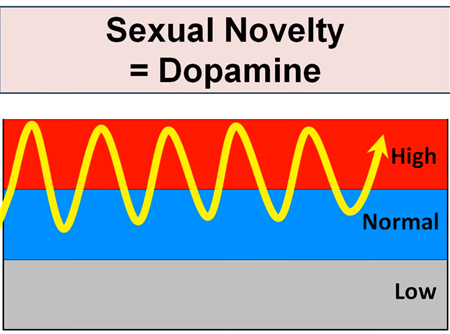
This explains why people addicted to Internet pornography open up several tabs in their browser at the same time. These people are addicted to the novelty of Internet pornography, rather than the sexual aspect per se. Many Internet pornography addicts claim they rarely watch a porn video to completion, but instead they surf from one video to another in order to stimulate their desire for novelty.
Our reward circuitry evolved when our ancestors were part of small hunter-gathering tribes. During the average hunter-gatherers lifetime, he or she would have sex with only a handful of other people. Thanks to the Internet, a person can view more potential mates in one afternoon than our ancestors would over several lifetimes.
Meet the Coolidge effect
Internet porn’s endless supply of sexual novelty is an unnatural stimulus exploiting something that’s been termed the ‘Coolidge effect’. This effect is best explained by an example. When you drop a willing female rat into a male’s cage, the male will continuously mate with the rat until he becomes bored. However, when you drop a different female rat into the cage, the male’s sexual appetite is awoken once more. You may repeat this process over and over again until the male rat collapses in exhaustion.
Why do the males become bored with the same female? Well, because the brain excretes less and less dopamine in respect of the current female, but a surge in dopamine occurs in the male’s brain when a new female is introduced. This mechanism helps promote genetic diversity and ensures no female goes unfertilized.
Internet pornography and the Coolidge effect
The below graph illustrates these same mechanisms hold true for the human brain when we watch Internet pornography. Arousal is skyrocketed exactly when new pornographic material is introduced:
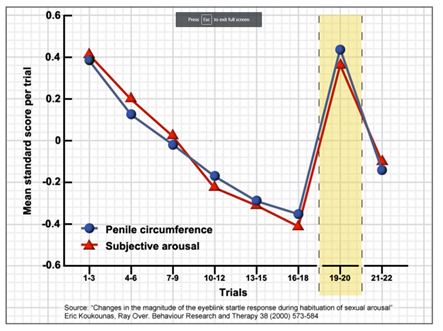
The above spike in arousal occurred when researchers switch to porn that the users had not viewed before. Without novelty and the Coolidge affect, there would be no spike in dopamine and no Internet porn addiction. Endless sexual novelty clearly means Internet pornography is a ‘super-normal’ stimulus in that it amplifies qualities we find especially compelling. Modern junk food and video games are another form of super-normal stimulus.
Super-normal stimulus at work
The term ‘super-normal stimulus’ was first coined by Nikolaas Tinbergen when he discovered birds and butterflies could be tricked into showing a preference to fake eggs and fake mates over their real counterparts. Furthermore, a male brown beetle will abandon mating with a female brown beetle in favour of mating with a brown beer bottle. These animals and insects are responding to cues that once lead to an evolutionary advantage but now lead to dead ends.
Is attempting to mate with a computer screen all that different to a bug attempting to copulate with a beer bottle? We believe it is not. Both humans, butterflies, birds and beetles are simply responding to supernatural cues.
Young men showing no interest in ‘real’ sex
A Japanese study titled “Young Men, Couples and Shunning Sex” found that in 2010, 36% of males aged between 16 and 19 had no interest in sex. This figure was double that found in 2008. The researchers believe this decrease in sexual interest is attributable to today’s Internet-oriented past times.
How Internet porn elevates dopamine levels
Besides endless sexual novelty, today’s Internet porn offers endless sexual stimulus thanks to artificially enhanced features such as Viagra sustained penises, double penetration, gang bangs and other unrealistic scenarios. Essentially, Internet porn violates our expectations. This violation of expectations elevates our dopamine to unnatural levels.
Below we summarise how Internet pornography may elevate dopamine levels:
- Novelty
- Violation of expectations
- Searching & seeking
- Anticipation of what’s next
- Shock & surprise
With high-speed Internet, people are unknowingly controlling their dopamine levels with a mouse and the click of a button. As soon as dopamine begins to drop, you may increase dopamine levels merely by clicking to the next pornographic video or by changing the genre of porn. Almost like magic, up goes your dopamine levels. This control of dopamine levels was not possible with earlier forms of porn such as magazines, VHS videos, or the even the Internet before high-speed was introduced.
Many Internet porn addicts describe a situation where they visit their favourite ‘tube’ websites. They will click through to around 20 different tabs of pornographic material with their right hand, whilst they masturbate with their left hand. These people do not complete any of these videos, but rather enjoy clicking to another video in order to sour their dopamine levels as they begin to drop.
Ever more shocking genres of porn to keep dopamine souring
Unlike still images of pornographic material, videos replace your need to stimulate your imagination and place you in a position of a voyeur. Only with high-speed Internet and ‘tube’ sites are you able to consistently boost your declining dopamine levels to unnatural highs and for an unnaturally lengthy period of time. Or you can boost your dopamine levels merely by switching to a new genre of pornography. If lesbian porn no longer excites you, you can switch to ‘girls with goats,’ or perhaps gang bangs or midget porn.
Watching Internet pornography may also cause you to experience shock, surprise and anxiety. This causes the release of ‘stress’ neurotransmitters and hormones such as norephinephrine, epinephrine and cortisol. These hormones increase excitement and amplify the effects of dopamine.
Porn addicts are known to escalate their porn use to ‘forbidden’ or ‘shame-inducing’ genres in order to boost declining dopamine levels. This is also known to encourage the release or these stress neurotransmitters. With time, a porn addict’s brain may mistake anxiety with sexual arousal. This may explain why porn users escalate to ever more shocking or anxiety evoking genres of pornography.
Are you an ‘edger’?
Some men are even known to maintain arousal for several hours in search for the ‘perfect’ scene to ‘finish them off.’ This is known as ‘edging’ your dopamine levels. This means you maintain high dopamine levels for hours on end and the brain strain that goes with it. This also overrides normal ‘satiation’ feelings.
An addiction to drugs and alcohol clearly have limits to them due to the toxic effects drugs and alcohol have on the body’s organs such as the liver and heart. However, Internet porn addiction is not restricted by these physical limits. You can watch Internet pornography day-in-day out and all day long.
What are the consequences of all this dopamine?
If you have managed to read this far, you may be wondering what damage all of this dopamine has on your brain. The consequences are mainly in the form of ‘brain changes’. These changes cause the symptoms and conditions listed earlier. These symptoms and conditions are physical and psychological in nature.
Skewing what’s acceptable sexual behaviour
One important psychological condition of Internet pornography addictions relates to men’s beliefs concerning what can be considered ‘normal’ sexual behaviour. For instance, some men may believe it’s normal to engage in anal sex and then to ejaculate over a women’s face. After all, they’ve witnessed this behaviour in countless pornographic videos over the years. Thus an addiction to Internet pornography skews attitudes and shapes perception regarding the boundaries of ‘normal’ sexual behaviour.
Replacing the need for real sexual experiences
An addiction to Internet pornography also gives rise to several unhealthy beliefs, such as ‘Internet porn is better than real sex’ or ‘I need to click from video to video in order to remain sexually aroused.’ Some men may even alter their sexual tastes due to years’ of exposure to Internet pornography.
Rewiring reward pathways and sensitisation
An addiction to Internet pornography may also cause physical changes in the brain. This change is known as ‘sensitisation’ aka.addiction. This occurs in the reward centre of the brain. The primary signal that causes this change is dopamine.
Addictive drugs or behaviours raise dopamine in the ‘reward centre’ of the brain as illustrated in the below diagram where the arrow is pointing:
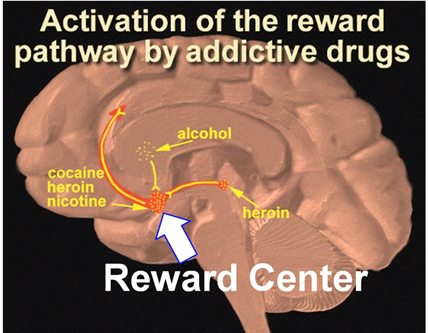
The technical name for the reward centre is the ‘nucleus accumbens.’ All addictive behaviours begin with elevated dopamine levels in the the reward centre of the brain. This is not to be confused with the ‘reward circuit’ explained above. In this way, sexual stimulus activates the same reward mechanism as drugs such as heroine, cocaine and crystal meth. Other natural rewards such as drinking water and eating activate a different set of nerve cells located in the brain’s reward centre.
As the diagram below illustrates, sexual arousal stimulates far higher levels of dopamine than any other ‘natural reward’:
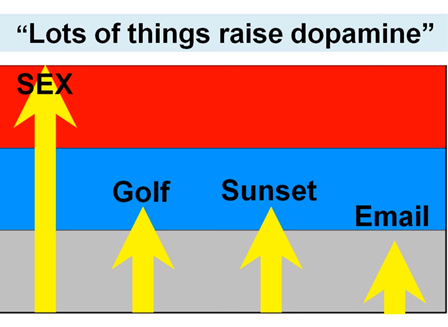
Thus, watching Internet pornography is potentially much more damaging than other Internet addictions such as playing video games. This is because playing video games does not affect the brain’s innate circuits in the same fashion as watching Internet pornography does.
What is sensitisation?
Sensitisation and sexual conditioning re-wire the brain’s reward centre nerve cells to want and crave certain behaviours. Sensitisation occurs when the brain wires together the sights, sounds, smells, sensations, emotions and memories associated with the big ‘reward’ such as masturbating to Internet porn. This creates a physical pathway that can blast our reward centre in the future. When this pathway is activated by cues and triggers (such as thinking about Internet porn), this pathway creates powerful and hard-to-ignore cravings. For instance, merely turning on your computer monitor may activate sensitised pathways that cause cravings for Internet porn.
Sensitisation is a form of unique and powerful ‘Pavlovian’ conditioning that alters the physical and chemical nature of your reward structure. Instead of salivating to the sound of a bell like Pavlov’s dogs, your reward circuits are stimulated when you turn on a computer monitor or when you see a sidebar banner of a semi-naked women on a non-pornographic website.
DeltaFosB and genetic survival via memory and repetition
Sensitisation begins with high levels of dopamine. This tells our primitive brain that this activity is really valuable and you should engage in this activity again and again. Dopamine’s goal is to have us remember and repeat behaviours that further our genetic survival. Dopamine achieves this by triggering a protein known as DeltaFosB. DeltaFosB remains in the brain for around eight weeks following your last ‘binge.’
DeltaFosB also activates certain genes that change the physical and chemical structure of the brain. As DeltaFosB levels rise, this protein begins to rewire the brain to crave for the substance or behaviour that led to a rise in DeltaFosB levels in the first place. This creates a circular process where ‘wanting’ causes ‘doing.’ This causes a surge in dopamine which leads to even more DeltaFosB being accumulated. As DeltaFosB accumulates, so does the urge to engage in the behaviour that created its accumulation in the first place. And so this cycle continues until you make a conscious effect to cease the addictive behaviour.
Sensitised pathways remain even when you quit your addiction
Thus, it’s really DeltaFosB that causes sensitisation and it does this by creating stronger and more powerful nerve connections in the brain. Long after an addict has quit ‘using’ and DeltaFosB levels have returned to normal, these sensitised pathways remain. This explains why alcoholics who have been sober for many years may still suffer from strong cravings when they walk into a pub.
Nerve cells that fire together will wire together
Sensitisation and learning are governed by this simple principle: nerve cells that fire together will wire together. When nerve cells experience pleasure, nerve cells carry that message to the reward centre by join together. Overtime, this pathway that carries this message becomes fixed. When a memory or cue activates memories related to this pleasure, a powerful craving arises because the pathways that allow this pleasurable cue to reach your reward centre are well established.
This is illustrated by the image below:
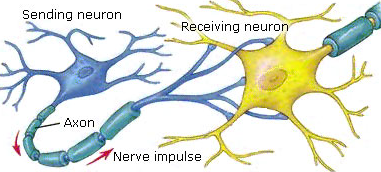
This is largely why sexual arousal caused by pornographic videos and images is preferable to sexual arousal from normal sex. Pornography becomes the path of ‘least resistance’ when it comes to dopamine release.
Neuroplasticity: how new reward pathways arise
Forming new brain pathways in this manner is known as neuroplasticity. This is how we learn and how we become addicted. Overtime, old brain pathways weaken. This is known as forgetting or breaking a bad habit. Creating or weakening brain pathways is often known as ‘rewiring’ the brain. Thus, neuroplasticity allows the brain to adapt as a result of experience.
In his book ‘The Brain That Changes Itself,’ Normal Doidge said: “The current porn epidemic gives a graphical demonstration that sexual tastes can be acquire. Pornography, delivered by high-speed Internet connection, satisfies every one of the prerequisites for neuroplastic change. ”
“The men at their computers looking at porn are uncannily like the rates pressing the bar to get a shop of dopamine.”
“Although they didn’t know it, they had been seduced into pornographic training sessions that met all the conditions required for plastic change of brain maps.”
If you’re looking for addiction recovery books, check out our guide on the best books on addiction recovery »
The dangers of watching porn for adolescent males
Unfortunately, the brain of a teen is far more plastic than that of an adult’s brain. This means the brain of teens and young men are primed to wire up to sexual cues. Thus, these people may be causing considerable and long-lasting damage to their brain by continuing to watch Internet pornography.
In the 1970s, a thirteen-year-old boy may have masturbated to his mental image of an attractive classmate or teacher. Today, this boy may be exposing himself to a multitude of porn ‘tube’ websites. This exposure to Internet pornography from such a young age is wiring our youths’ brain to becoming addicted to pornography and to cause possible sexual dysfunction in their later teens when real sexual experiences become a possibility.
Competing pathways for porn and normal sexual experiences
For the thirteen-year-old boy, watching Internet pornography gives rise to two competing sexual pathways. The first is the pathway for healthy and natural sexual experiences, whilst the other gives rise to a pathway for unnatural urges to watch Internet pornography. The sensitised pathway for porn is now the preferred pathway because it is more established and leads to a bigger reward than the normal pathway.
If the teenage boy engages with Internet pornography on a daily basis, the pathway to engage in natural and normal sexual relations will fail to keep pace. This means the desire to engage with Internet porn will cause this young addict to struggle with normal loving and sexual relations as they present themselves in early adulthood.
Again, in his book ‘The Brain That Changes Itself,’ Normal Doidge said: “Because plasticity is competitive, the brain maps pathways for new, exciting images images at the expense of what had previously attracted them.” Thus the brain is trained to expect sexual arousal under unnatural conditions.
Conditions that encourage unnatural pathways for Internet porn addiction
The conditions that establish this unnatural pathway for porn-induced sexual arousal include:
- Being alone
- Voyeurism
- Continuously searching and seeking new pornographic material
- Opening multiple tabs to watch multiple porn videos in quick succession
- Pornographic novelty
- New pornographic genres to overcome boredom
Whilst this type of sexual conditioning is far more powerful during adolescence, it can occur at any age. This disparity between real sex and pornographic aided masturbation is a major factor for both porn-induced erectile dysfunction (ED) and the inability to stop using pornographic videos. If you suffer from a porn-induced fetish or porn-induced ED, you will need to stop using porn to literally ‘rewire’ your pathways so you exhibit a preference to real-life people. This is known as ‘rebooting’.
Similarities between Internet porn and drug addiction
A 2013 study concluded that: “Natural and drug rewards not only converge on the same neural pathways, they converge on the same molecular mediators and likely in the same nerve cells to influence the wanting of both types of rewards.” This means that cravings for addictive drugs or for porn tap into the same mechanisms and brain circuits (i.e. DeltaFosB).
Another study conducted by researchers at Cambridge University in 2014 compared people addicted to Internet porn to control groups consisting of people who were not addicted to Internet porn. The results of the study were alarming. Sensitisation to porn was clearly exhibited by the porn addicted group when they were exposed to Internet porn. The porn addicts’ reward centre lit up when exposed to porn. This was not the case for the control group. These results are similar to other studies that show the reward centre of drug addicts light up when they are exposed to
These results are similar to other studies that show the reward centre of drug addicts light up when they are exposed to drug related cues and triggers.
The below image illustrates that the ‘reward centre’ lits up when porn addicts are exposed to Internet porn:
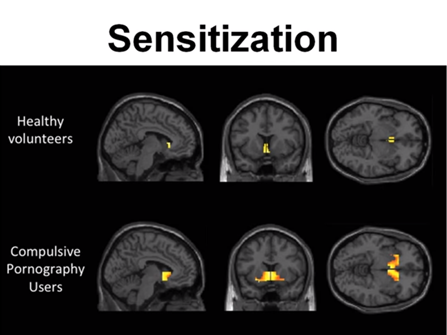
Incentive salience: when wanting is divorce from liking
Like drug addicts, porn addicts also suffer from a psychological condition known as ‘incentive salience’. This is when the desire to watch Internet porn is divorced from the person’s sense of liking for watching Internet porn. This means the person continues to watch Internet porn despite feeling shameful and other negative emotions as a result.
Incentive salience arises due to neurological pathways developing between the addictive behaviour and the release of dopamine in the brain’s reward centre. This is why addicts of porn or drugs continue to want to engage in this behaviour even though they do not wish to do so.
Dopamine release allows us to develop incentive salience to activities that allow us to survive e.g. eating food and sex. However, Internet porn or drug use hijack this system so dopamine release becomes sensitive to these activities and to ‘cues’ leading up to these activities. This causes a condition known as ‘incentive sensitisation’. This means cues that encourage these activities become impossible for the addict to ignore without engaging in the addictive behaviour. This hyper-sensitivity to cues encouraging drug or Internet porn use can continue many years even once the addict has quit these activities.
The 4 Cs Of Addiction
The term ‘addiction’ is abstract for many people who are learning about the topic. Fortunately, the ‘4 Cs’ model has been developed to help define an ‘addiction’ in concrete terms. Specifically, the 4 Cs model is a screening test to diagnose whether an addiction has or has not arisen.
Below we apply the 4 Cs model to Internet porn addiction:
- Continued use of Internet porn in spite of negative consequences. Most porn users will have no idea they are suffering from negative consequences until they try to stop using Internet porn
- Compulsion to use Internet porn e.g. thinking about porn when not watching porn, or eagerly anticipating porn
- An inability to control the use of Internet porn e.g. you try to stop using Internet porn but you can’t
- Craving: psychological or physical craving for Internet porn. Cravings can be triggered by internal or external cues
Internet porn withdrawal symptoms
If you are addicted to Internet porn, you may experience withdrawal symptoms when you attempt to stop.
These symptoms include:
- Anxiety
- Restlessness
- Irritability
- Insomnia
- Fatigue
- Poor concentration
- Depression
- Mood swings
- Social isolation
- Headaches
- Severe loss of libido (know as ‘the flatline’)
Brain changes associated with Internet porn addiction
Below we list the four brain changes that occur when you become addicted to Internet pornography:
- Sensitisation: this includes hyper-reactivity to addiction cues and cravings for Internet porn
- Desensitisation: this describes a numbed pleasure response you may experience when you watch Internet porn due to a decline in ‘feel good’ chemicals such as dopamine, opioids and their receptors. Desensitisation causes a higher tolerance i.e. the need for more and more Internet porn just to get a ‘buzz’
- Hypo-frontality: a weakened impulse control/willpower caused by inhibited frontal lobes
- Altered stress response: when even minor stress cues lead to cravings and relapse because they activate powerful and super-sensitive reward pathways in the brain
How desensitisation affects Internet porn addicts
The below image illustrates how desensitisation affects Internet porn addicts. On the left of the diagram, we have sensitisation caused by the addiction and on the right we have desensitisation to everything else we experience in life. Any cues associated with the addiction cause the reward circuit to reward you with dopamine. However, everything except the addiction begins to trigger far less dopamine. This means you are motivated to engage with Internet pornography, but you are de-motivated to engage in other healthier activities such as sexual attraction to real people or engaging in hobbies and other social events. Thus, addiction to Internet porn creates an imbalance between cravings for Internet porn caused by sensitisation and the ability to experience pleasure from everyday activities caused by desensitisation.
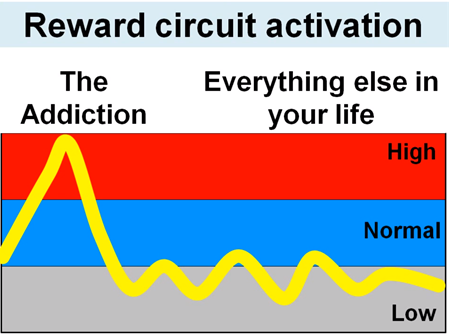
Desensitisation involves low dopamine signalling for everyday activities. This is known as ‘reward deficiency’ and ‘numbered pleasure response.’ This causes the Internet addict to engage in dopamine releasing activities e.g. watching more Internet pornography. Unfortunately, sensitisation reward pathways caused by Internet porn addiction provide the easiest route to a guaranteed dopamine surge.
Desensitisation causes tolerance to Internet pornography. The addict will require a higher dose of Internet pornography in order to achieve the required dopamine release and associated opioid release. This means Internet pornography addicts will spend more and more time online searching for that ‘perfect’ porn video. Searching for Internet porn thus consumes an ever increasing amount of time. This may affect an addict’s work, education or relationships.
Desensitisation and the ‘acquisition’ of new fetishes
Tolerance may also mean you are forced to escalate to new and more shocking genres of porn in order to experience the desired ‘buzz.’ This may mean you begin to watch porn of a violent or even an illegal nature. Some may transition to porn that does not match their ‘natural’ sexual preference. This may mean a straight person begins to watch gay pornography or a gay person may begin to watch straight pornography. Remember, shock, surprise and anxiety are capable of elevating slumping dopamine levels. Japanese anime Hentai is a perfect example. These cartoons depict sexual scenes that are too vile or violent to
Remember, shock, surprise and anxiety are capable of elevating slumping dopamine levels. This may explain why this occurs. Japanese anime Hentai is a perfect example. These cartoons depict sexual scenes that are too vile or violent to ‘act out’ in real life. Within a relatively short period of time, the Internet porn addict ‘acquires’ more and more vile fetishes due to desensitisation.
How desensitisation occurs
To understand desensitisation, you must understand how individual nerve cells communicate. Dopamine-producing nerve cells affected by desensitisation originate from the beginning of the reward circuit and make connections with other nerve cells in the reward centre. Nerve cells send messages using chemicals such as dopamine. Nerve cells bond to each other to form a ‘reward pathway’.
Messages associated with Internet porn travel via reward circuit nerve cells. Nerve cells send these messages by releasing dopamine into the space that separates adjacent nerve cells. Once released, dopamine races to the next nerve cell in the chain of the reward pathway. Desensitisation causes a decline in the amount of dopamine available for transferring messages from one nerve cell to the next.
A decline in dopamine: a loss of ‘grey matter’
When you watch Internet porn on a constant basis, nerve cells eventually say ‘enough is enough.’ Nerve cells achieve this by removing dopamine receptors and by producing less dopamine available to transfer to adjacent dopamine receptor cells. This causes weaker dopamine signals and hence less excitement when you continue to watch Internet porn.
Overtime, over-exposure to Internet porn may cause permanent structural change, such as a decline in the number of nerve connectors or synapses. The branch-like parts of nerve cells begin to fade away. Since the branch-like parts of nerve cells appear to be grey, this is known as ‘loss of grey matter.’
Loss of grey matter translates into fewer nerve cell connections, less dopamine connections, less dopamine and a corresponding need for greater stimulation to fill this void in dopamine loss. This condition was demonstrated in a 2014 you can read here. This study concluded that regular use of Internet pornography ‘more or less wears out your reward system’ and that ‘consumption of Internet porn causes the individual to seek out novel and more extreme material.’
Weakening of Hypo-frontal lobes and loss of willpower
The same study also found that an addiction to Internet pornography causes hypo-frontality in the brain. Hypo means ‘below normal’ or deficient and ‘frontal’ refers to the frontal lobes located in the brain. The frontal lobes have been described as the brain’s ‘brake’ that says ‘don’t do it’ to activities that may harm us. Hypo-frontality means the frontal lobes undergoes chemical and structural changes leading to weakened willpower and an inability to control Internet porn use. In fact, the hypo-frontality shrinks the size of the frontal lobe weakening your ability to say ‘no.’ This is known as frontal lobe atrophy.
The study found that the nerve cells connecting the reward circuit and the frontal lobes weakened with continued porn use. The study concluded that “dysfunction of this circuitry has been associated with inappropriate behavioural choices such as drug seeking, regardless of negative outcomes.”
Humans exhibit well developed frontal lobes. This gives us humans most of our intelligence, logic and problem-solving abilities. The frontal lobes are involved in many complex functions such as planning, judgement, impulse control, willpower and risk-assessment. The frontal lobes prevent us from taking action we may later regret such as punching our boss, screaming at our kids or binging on Internet porn before an important examination. With addiction, the balance of power shifts away from our logical frontal lobes to our more emotional reward circuit.
Meditation is believed to be one of the most effective ways of strengthening the frontal lobes, and hence a powerful tool in the fight against Internet porn.
Altered stress response due to porn addiction
Now we shall discuss the last major brain change caused by an addiction to Internet pornography. This refers to the altered stress response you will experience when you become addicted to Internet pornography. This means minor stress leads to cravings and/or relapse.
When you attempt to withdraw from watching Internet porn, a stress response is activated via your brain’s stress systems. This stress response causes withdrawal symptoms and relapse. Researchers believe stress activates sensitised reward pathways and also inhibits our frontal lobes that would otherwise give us the willpower to ignore these cravings for Internet porn. This is why many relapses can be attributed to stressful events. This also explains why stress reducing strategies such as meditation, exercise and socialising are so helpful at preventing relapse.
Rebooting: a viable cure?
If you suffer from a porn addiction and particularly porn-induced erectile dysfunction, we recommend you undertake what’s been termed a ‘reboot.’ This requires you to unplug your brain from all artificial sexual stimulation. This includes avoiding Internet porn, but also other distractions such as YouTube, FaceBook, dating website etc. This means stepping away from your computer monitor and stop clicking in order to receive your dopamine hits.
If you accidentally ‘bump’ into sexual material online, that’s not a problem. Problems arise when you actively go looking for such materials.
Becoming a participant rather than a voyeur
Robooting is about training your brain to be a participant rather than a voyeur. The goal of a reboot is to seek your pleasure from real people rather than digital representations of people. Over time, this means sensitised porn pathways will weak and desensitisation will fade away. ‘Real person’ pathways will begin to overtake unhealthy porn pathways. This means you will receive your dopamine hits from real-life interactions instead of unhealthy Internet porn.
Masturbation during a reboot
What about masturbation during a reboot? Well, some rebooters prefer to temporarily eliminate or drastically reduce masturbation and orgasms during their reboot, particularly if the person suffers from porn-induced sexual problems. However, we urge you to experiment and find a balance that suits your needs. If you do insist on masturbating during your reboot, do so without porn or recalling porn.
Activities that speed up your reboot
Hypofrontality also reverses, but this takes time. You may speed up this process by engaging in activities such as meditation that are known to engage your frontal lobes. This will help reverse hypofrontality and thus strengthen your willpower. This will mean urges will become easier to ignore and healthy choices such as exercising and socialising will become far more appealing.
Fading unhealthy pathways and strengthening healthy pathways
What about sensitised porn pathways that are behind your addiction to porn and cravings? The good news is that nerve cells that form this pathway will slowly but surely begin to disperse from one another. However, the bad news is this pathway for Internet porn addiction will never completely untangle, although it will fade and weaken. This explains why you will experience cravings even after years of abstaining from Internet porn use.
A word of warning
When you initially quit using Internet porn, the sensitised pathways will temporarily grow stronger and more sensitive to addiction cues and triggers. Studies show these connections continue to strengthen for around seven days following your decision to quit Internet porn, and begin to fade within around four weeks into your abstinence.
Why do sensitised pathways initially grow stronger when you try to quit Internet porn? This is because these pathways are designed by evolution to cause us to crave for natural rewards such as sex or food. If we give up on these natural rewards, we will die or fail to reproduce. An addiction to Internet porn hijacks this natural survival mechanism causing you to experience strong cravings when you attempt to give up Internet porn.
Please note that rebooting is not a linear process where you continue to improve each day. Instead, you will experience good days and bad days in terms of your mood. Mood swings will continue for around seven months into your reboot.
Useful Resources
- Your Brain on Porn
- Your Brain Rebalanced
- Reboot Nation
- The Brain that Changes Itself by Norman Doidge
- Natural and drug rewards act on common neural plasticity mechanisms with DeltaFosB as a Key Mediator (2013)
- Neural Correlates of Sexual Cue Reactivitity in Individuals with and without Compulsive Sexual Behaviours
- Enhanced Attentional Bias towards Sexual Explicit Cures in Individuals with and without Compulsive Sexual Behaviours
- Brain Structure and Functional Connectivity Associated With Pornography Consumption: The Brain on Porn
- The Neurobiology of Addiction by Robbins et al
- Drugs, Addiction and the Brain by Koob et al
- Memoirs of an Addicted Brain by Marc Lewis, 2013
- Reddit board on quitting Internet pornography
John Gillen
- Author
- Last updated: January 13, 2022
John is one UK’s leading professionals in the addiction recovery industry. Pioneering new treatment techniques such as NAD+ and ongoing research into new therapy techniques such as systematic laser therapy, John is committed to providing the very best treatment for people throughout the UK and Europe. During his extremely busy schedule, John likes to regularly update our blog section with the latest news and trends in the industry to keep visitors to our site as well informed as possible on everything related to addiction treatment.
Request A Callback
Enter your phone number and a member of our team will call you back to discuss your recovery.
Contact Us
For more information please get in touch using the information below
Call: 01253 847 553 Send us a messageDownload Our Brochure
For more information about the addiction services that Ocean Recovery offer, download our brochure.
Download our brochureDo I need help?
A lot of people are unsure if there are suffering from addiction. Take these tests to find out if its effecting you without your knowledge.
Select your test and find out more
Our Centre
Rehab In Northern England

Google Reviews
4
Tel: 01923 369161
Email: info@oceanrecoverycentre.com
Address: 94 Queen's Promenade, Blackpool, FY2 9NS
View CentreOur Partnering Centres
Rehab in Scotland

Google Reviews
5
Tel: 01475 303998
Email: info@novarecovery.com
Address: 10-12 Scott St, Largs, North Ayrshire, KA30 9NU
View CentreRehab in Greater London

Google Reviews
4.5
Tel: 01923 369 161
Email: info@cassioburycourt.com
Address: Cassiobury Court, Richmond Drive, Watford, Herts, WD17 3BH
View CentreRehab in the Midlands

Google Reviews
4.5
Tel: 01908 489 421
Email: info@asanalodge.com
Address: 48 Moorend Rd, Yardley Gobion, Towcester, NN12 7UF
View Centre